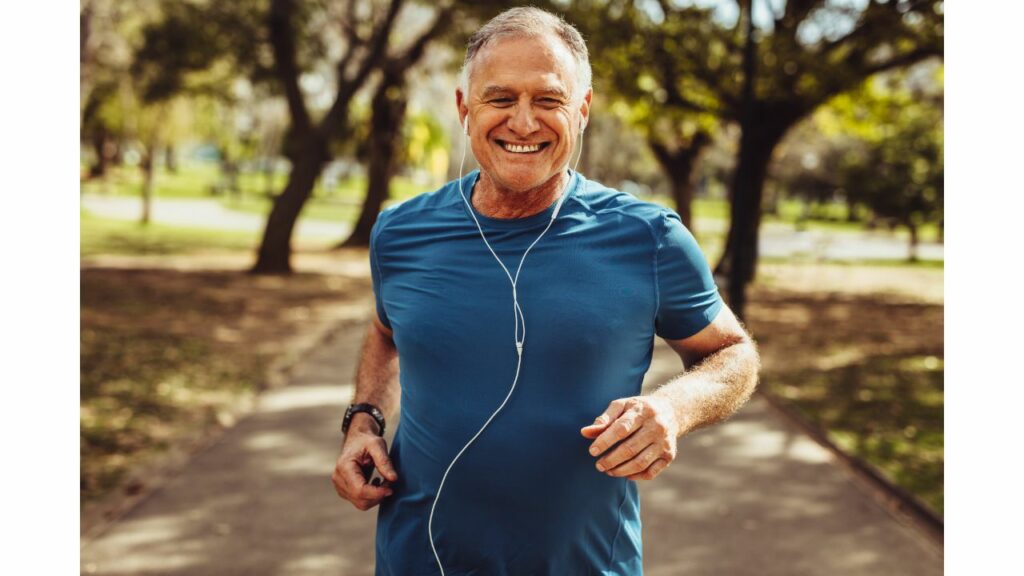Every time I lace up my sneakers and hit the gym floor, I notice a significant shift in my mood. Regardless of the day I’ve had, a good workout always seems to wash away the stress and leave me feeling revitalized and, surprisingly, happier.
This personal observation isn’t just anecdotal; it’s a phenomenon experienced by countless individuals who incorporate exercise into their routines. But why does working out make us feel this way? Is there a scientific basis that explains the surge of happiness post-exercise?
The concept of exercise-induced happiness is fascinating and multi-faceted, involving a blend of biochemical, psychological, and emotional factors.
In this blog, I’ll dive into the “science behind the smile” and explore how physical activity can significantly uplift our mood. I’ll discuss the role of endorphins, and the “feel-good” chemicals, and examine other neurotransmitters at play.
Additionally, I’ll touch on how the physical benefits of working out extend beyond muscle tone and cardiovascular health, impacting our psychological well-being. So, whether you’re a seasoned athlete or someone considering taking up a new fitness regimen, understanding the happiness-boosting effects of exercise might just provide the motivation you need to get moving.
The Science Behind the Smile: Understanding Endorphins
Endorphins are often the stars of the show when discussing the mood-enhancing effects of exercise. These natural chemicals in the brain are part of our body’s pain-relief system. When we engage in physical activity, especially something intensive like running, lifting weights, or even a vigorous yoga session, our bodies produce higher levels of these neurotransmitters. But what exactly are endorphins, and how do they work?
Endorphins are peptides that help relieve pain and induce feelings of pleasure or euphoria. They’re produced by the central nervous system and the pituitary gland and are often referred to as the body’s natural opiates. When you’re in the middle of a challenging workout and you hit what’s popularly known as the “runner’s high,” that’s endorphins at work. They essentially mask discomfort, which can be particularly noticeable during and after high-intensity interval training or long-distance running, making the activity not just bearable but also enjoyable.
The relationship between exercise and increased endorphin levels has been substantiated by numerous scientific studies. For example, research published in the Journal of Endocrinological Investigation highlights how regular physical activity elevates endorphin levels, leading to improved mood and decreased feelings of depression.
Another study, featured in the Neuroscience Letters, provides evidence that high-intensity exercise stimulates the production of endorphins, helping to alleviate anxiety and stress.
Beyond Endorphins: The Full Spectrum of Happy Chemicals
While endorphins often steal the spotlight in discussions about the mood-boosting effects of exercise, they’re just one part of a much larger picture. Exercise influences the brain on multiple fronts. It increases the production of several key neurotransmitters that play critical roles in our mood and overall emotional well-being: serotonin, dopamine, and norepinephrine.
Let’s delve into how each of these contributes to the feel-good factor associated with working out and how regular physical activity can enhance brain function and emotional health.
Serotonin is often called the happiness chemical for a good reason. It helps regulate mood, anxiety, and happiness. Low levels of serotonin are associated with depression and anxiety, whereas higher levels are linked to improved mood and emotional stability. Exercise, particularly aerobic exercises like running, cycling, and swimming, can boost serotonin levels, helping to improve mood and create a sense of calm.
Dopamine is the brain’s reward chemical. It’s released during pleasurable situations and stimulates us to seek out the enjoyable activity or occupation over and over. Physical activity increases dopamine production, which not only improves mood but also motivation, attention, and learning. The dopamine release associated with exercise is why accomplishing a workout can feel so rewarding and why it can become a positive habit.
Norepinephrine plays a key role in helping our brains cope with stress. Exercise stimulates its production, enhancing our body’s ability to respond to stress. This can lead to improved cognitive function, alertness, and energy, contributing to an overall sense of well-being.

Physical Benefits that Lead to Psychological Well-being
The psychological benefits of exercise go beyond the biochemical. There’s a significant connection between the physical benefits of exercise—such as improved strength, endurance, and flexibility—and mental health. As we engage in regular physical activity, we not only see improvements in our physical health but also experience a boost in self-esteem and confidence.
Achieving fitness goals, whether it’s running a certain distance, lifting a new maximum weight, or mastering a complex yoga pose, can provide a profound sense of accomplishment. This progress, often visible in the mirror and in what our bodies can achieve, reinforces our self-worth and can be a powerful motivator.
The discipline and dedication required to maintain a fitness regimen also translate into personal empowerment. They remind us of our ability to influence aspects of our lives positively.
Moreover, the physical benefits of regular exercise – such as better sleep, increased energy levels, and improved physical appearance—further contribute to a positive mental outlook. When we feel good physically, it’s easier to maintain a positive attitude towards life. This positive feedback loop between physical and psychological well-being is a key aspect of why exercise is so effective at boosting happiness.
The Social Aspect of Exercise
Beyond the individual physiological and psychological benefits of exercise, there’s a powerful social component that significantly contributes to our overall sense of happiness and well-being.
Engaging in group workouts, team sports, or any form of communal physical activity can create a strong sense of community and belonging, further enhancing the joy and satisfaction derived from exercise.
Fostering a Sense of Community and Belonging
Participating in group workouts or team sports naturally brings individuals together, sharing common goals, challenges, and achievements. This shared experience can quickly turn strangers into friends, fostering a supportive environment where encouragement and motivation are freely exchanged.
The sense of belonging to a group or team provides not just social fulfillment but also accountability, making it easier to stick with a fitness regimen.
The camaraderie developed through regular group exercise sessions can be a significant source of emotional support. Knowing you’re not alone in your fitness journey can be incredibly reassuring, especially on days when motivation is lacking. The collective energy of a group can lift individual spirits, making workouts feel less like a chore and more like a shared adventure.
The Role of Social Interaction in Enhancing Mood
Social interaction during exercise plays a crucial role in enhancing mood. Engaging with others while working out can provide a distraction from the physical exertion, making the activity more enjoyable and lessening the perception of effort.
Laughter, encouragement, and the simple presence of others can elevate the exercise experience, transforming it into a social outing rather than just a physical task.
Moreover, the positive social interactions experienced during group activities can lead to increased feelings of happiness and decreased feelings of stress and anxiety.
The emotional bonds formed through regular social exercise can contribute significantly to our overall mental health, offering both immediate mood boosts and long-term emotional resilience.

Finding Your Happy Workout: How to Make Exercise Enjoyable
While the benefits of exercise are clear, finding the motivation to start and maintain an active lifestyle can be challenging. The key to long-term success is discovering physical activities that are not just beneficial but also enjoyable and motivating.
Tips for Discovering Enjoyable Physical Activities
- Experiment with Different Types: The world of fitness is vast and varied. From dance classes and hiking to martial arts and swimming, there’s something for everyone. Trying different activities can help you discover what you genuinely enjoy.
- Consider Your Interests: Reflect on what you enjoy in other areas of your life. If you love the outdoors, try running, cycling, or rock climbing. If you prefer social settings, consider team sports or group fitness classes.
- Set Fun Goals: Instead of focusing solely on weight loss or muscle gain, set goals to learn a new skill, like mastering a yoga pose or completing a 5K run. Achieving these goals can provide a sense of accomplishment and joy.
- Involve Friends or Family: Exercise can be more enjoyable when shared. Invite friends or family members to join you in your workouts, turning them into social events.
- Mix It Up: Variety is the spice of life, and this applies to exercise too. Mixing different types of workouts can keep things interesting, preventing boredom and maintaining your interest over time.
- Listen to Your Body: Choose activities that feel good. If something causes discomfort or doesn’t excite you, it’s okay to try something else. Your workout should be something you look forward to, not dread.
Encouragement to explore and experiment with various forms of exercise can lead to a more enjoyable and sustainable fitness journey. By finding activities that you truly enjoy, you’ll be more likely to integrate physical activity into your daily life, reaping the mood-boosting benefits of exercise while also having fun.
Real-Life Success Stories
Throughout my journey in fitness, I’ve encountered numerous individuals whose stories of transformation through exercise are both inspiring and heartwarming. These testimonials serve as powerful reminders of how physical activity can profoundly impact our mental health and overall well-being.
Personal Testimonial from the Author
For me, fitness has always been more than just a routine; it’s a form of therapy. After a hiatus due to academic commitments, returning to the gym was like finding my way back home. The physical exertion helped clear my mind, and the progress I saw in my strength and endurance brought a deep sense of accomplishment and joy.
Overcoming the challenge of balancing fitness with other life responsibilities has made the journey all the more satisfying.
Testimonials from Others
- Emma’s Story: After struggling with anxiety for years, Emma found solace in yoga. The practice’s combination of physical movement, breathing exercises, and meditation provided her with a peaceful escape from her daily stresses, significantly improving her anxiety symptoms.
- Mark’s Transformation: Mark turned to running as a way to cope with a stressful job. Initially, it was a struggle to even run a mile, but persistence led to progress. Completing his first marathon was a turning point. Not only did his physical health improve, but the sense of achievement also lifted his spirits and boosted his self-confidence.
- Lily’s Journey: Lily discovered swimming after a back injury made most forms of exercise painful. The weightlessness and resistance of water allowed her to build strength without strain. This not only aided her physical recovery but also helped her overcome the frustration and depression that followed her injury.
These stories, each unique in their challenges and triumphs, highlight the diverse ways in which exercise can enhance our mental health and bring joy and satisfaction into our lives.
Conclusion
Throughout this exploration of why working out makes us happy, we’ve delved into the scientific underpinnings of exercise-induced euphoria, the social benefits of group activities, and the personal satisfaction that comes from achieving physical goals. The mood-boosting effects of exercise are supported by a wealth of scientific evidence and personal testimonies alike, showcasing the profound impact of physical activity on emotional and psychological well-being.
I encourage everyone to integrate physical activity into their daily life, not just for the physical benefits but for the mental and emotional uplift as well. The fitness journey is as much about discovering joy and satisfaction in the movements that make us feel alive as it is about health and endurance.
The transformative power of exercise on happiness cannot be overstated. For me, the return to fitness has been a journey of rediscovery, a reminder of the strength and resilience within us all. It’s a path that has led not only to improved physical health but to a happier, more fulfilled life.



